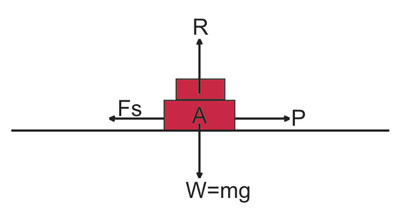|
Friction or frictional force is
the force that acts between two surfaces in contact. When the surfaces of two
bodies are in contact with each other, a force is required to move or slide one
of them over the other. This is because there is usually another kind of force,
which acts to oppose or prevent the movement of one body over the other.
This opposing force is known as
friction and its magnitude depends on the nature of the surfaces of the bodies
in contact.
Friction can be defined as a
force, which acts at the surface of separation of two bodies in contact and
tends to oppose the motion of one over the other.
Friction
is an electromagnetic force, generated by the charged particles of the materials
in contact. As an electromagnetic force, the value of friction cannot be
determined from first principles or postulates, and so cannot be derived from
calculations.
Friction
can only be calculated by empirical means, which means it requires information
obtained from experience or experiment to be able to calculate the friction
between two surfaces in contact with each other.
In
the process of the surfaces of two bodies rubbing against each other, energy
conversion usually takes place. The friction acting between them changes kinetic
energy into thermal or heat energy.
Types Of Friction
There
are two types of friction, namely static
friction and kinetic
friction. Static friction, also
called limiting friction takes place when there is no motion, while kinetic
friction, also known as dynamic or sliding friction occurs when there is motion.
Laws Of Friction
The laws governing solid
friction can be summarized as follows:
- Friction
opposes motion.
- Friction
is independent of the area of the surfaces in contact.
- Friction
depends on the nature of the surfaces.
- Friction
is independent of relative velocity between the surfaces.
- Frictional
force F is proportional to the normal reaction R, exerted by the surface of
the material on which a body rests.

As shown in the diagram above,
the normal or perpendicular reaction R exerted by the surface on the body A is
equal and opposite to the weight
W of A.
Therefore, R = W
= mg
From experiments, it is found
that when R is increased by adding more weights to A, the static frictional
force, F also increases as the minimum force P needed to move A increases.
Therefore, the static
frictional force, F is proportional to the normal reaction R.
F
α
R
F
= µR
=
µmg
or
F/R =
µ
F =
µR
or
F =
µmg
is the friction equation or formula.
The
friction constant µ is
known as the coefficient of friction for the two
surfaces, and it’s true for
both static
friction and kinetic
friction.
See
more friction topics here.
See coefficient of static friction here.
See coefficient of kinetic friction here.
See calculating friction here
|